~ The Ordnance Dept 1812-1860 ~
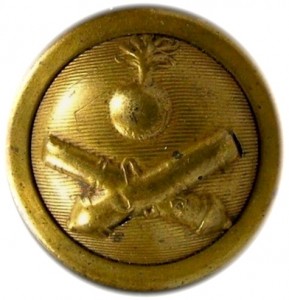
1830-40’s Ordnance Department Button
When the War of 1812 first broke out the US Army was not acclimatized in supplying ammunition, artillery, and equipment to the various infantry and artillery units for proper engagement. To counter this problem the Army established an Ordnance department immediately as proactive measures to ensure successful offensive and defensive campaigns. By 1815 at the wars end, the Ordnance department was properly procuring assets to meet the needs of the troops, and developing artillery. After the war of 1812 there was a steady decline in appropriations by Congress, and by 1821, the Ordnance department was merged with the Artillery branch of the Army. The merger wasn’t a complete unification, but a departmental one where the Ordnance department was able to keep their distinct function, but just under the Artillery department umbrella.
In 1832 under President Andrew Jackson, the department was once again reorganized, and fully restored to its previous status as its own entity. The departments main mission remained the development and procurement of weapons to the various military units. The earliest recorded reference to button designs is a General Order Adjt. & Inspection of March 15, 1816: The uniforms will be the same as the Artillery, except for the buttons which will have an Eagle on a cross cannon pattern.

 

1812-21 Federal Ordnance Department
Color: Gold.
Metal: Flat, 1-Piece, Raised Design, Gilt Brass.
Size: 23mm. Coat Size
Albert’s Number: OC 1-B: RV 35
Tice’s Number: ORD100B.1
Variation: Eagle Facing Left / Ringed Cross Cannons / 3 Cannon Balls / Single Ring Breech.
Present Condition: A Non Excavated Example, Strong Planchet Condition, A Strong High Relief Pattern Remains.
Isabela’s Notes: This is the first ordnance pattern that was issued. There are three known die variants in this original series. All depict the eagle facing left standing on a set of cross cannons. This button’s pattern depicts an Eagle Facing Left while perched on a set of Ringed Cross Cannons. There are Three Cannon Balls in a pyramidal shape underneath the Cross Hatch of the cannons. The pattern is set on a circular lined field in high relief. There is an outside 1.5mm raised picture frame border around the inner lined field. The is an exceptional example of this old button.
Reverse Button Analysis: This is a flat one-piece button with a loop shank. The shank is original, straight, and intact. LEWIS & TOMES. EXTRA RICH. In a depressed channel.
The J. Baldwin Collection.
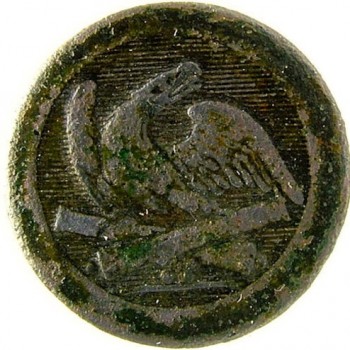
 

1812-1821s Federal Ordnance Department
Color: A Golden Silver with Green Encrustations.
Metal: Flat, 1-Piece, Raised Design, Gilt Brass.
Size: 21.5mm. Coat Size
Albert’s Number: Similar to OC 1-A: RV 35
Tice’s Number: Similar to ORD100A.1
Variation: Flat Head Eagle Facing Left / Ringed Cross Cannon / Three Cannon Balls underneath the Cross Hatch.
Present Condition: An Excavated Speciemn, Strong Planchet Condition, A Good High Relief Pattern Remains.
Isabela’s Notes: This is an earlier die variant of the first series. Either this button was supplied by an English manufacturer prior to Armitage, or Armitage didn’t over stamp the reverse planchet. We know that Armitage / Phil used this earlier planchet and struck over the H. T & D Treble Gilt Strand Colour English Back mark. This button’s pattern depicts a Flat Head Eagle Facing Left while perched on a set of Ringed Cross Cannons. There are Three Cannon Balls underneath the Cross Hatch of the cannons. The pattern is set on a circular lined field in high relief. There is a raised picture frame border around the inner lined flat field. This button could have been issued later and used in the 1830’s. (Treble 55)
Reverse Button Analysis: This is a flat one-piece button with a loop shank. The shank is original, straight, and intact. TREBLE GILT STANDD COLOUR within a 2 dm ring.
This Button was Dug in Charleston, South Carolina.~
Picture Courtesy of Harry Ridgeway.
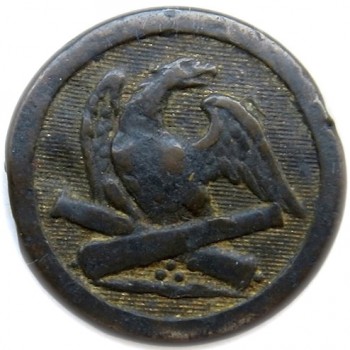
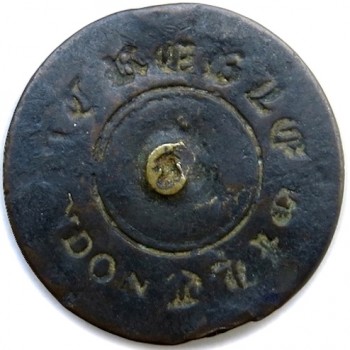
1812-1821s Federal Ordnance Department
Color: A Golden Silver with Green Encrustations.
Metal: Flat, 1-Piece, Raised Design, Gilt Brass.
Size: 21.98mm. Coat Size
Albert’s Number: OC 1-C: RV 35
Tice’s Number: Similar to ORD100A.1
Variation: Round Head Eagle Facing Left / Ringed Cross Cannon / Three Cannon Balls underneath the Cross Hatch.
Present Condition: An Excavated Specimen, A Good Planchet Condition, A Good High Relief Pattern Remains.
Robert’s Notes: There appears to be at least 3 variations of this button, but there maybe another die variant. The depiction remains constant, only the depiction of the eagle varies slightly. This button’s pattern depicts a Round Head Eagle Facing Left while perched on a set of Ringed Cross Cannons. There are Three Cannon Balls in a pyramidal shape underneath the Cross Hatch of the cannons. The high relief pattern is set on a evenly lined field. There is a raised circular picture frame edge border.
Reverse Button Analysis: This is a flat one-piece button with a loop shank. The shank is unfortunately missing.
The RJ Silverstein Collection.
1812-21? Federal Ordnance Department
Color: Gold.
Metal: Flat, 1-Piece, Raised Design, Gilt Brass.
Size: 23mm. Coat Size
Albert’s Number: Unlisted Variant.
Tice’s Number: Unlisted Variant
Variation: Eagle Facing Left / Ringed Cross Cannons / 10 Cannon Balls / Double Ring Breech.
Present Condition: An Excavated Example, Good Planchet Condition, A Strong High Relief Pattern Remains.
Isabela’s Notes: This is an unknown die variant made in England. This button’s pattern depicts a Spread Wing Eagle Facing Left while standing on a set of Ringed Cross Cannons. There are Ten Cannon Balls in a pyramidal shape underneath the Cross Hatch of the cannons. The pattern is set on an evenly lined field in high relief. There is an outside picture frame border with an outer rope edge. There is some merit that this might be an Ordnance department which supplied artillery and munitions to naval vessels.
Reverse Button Analysis: This is a flat one-piece button with a loop shank. The shank is original, straight, and intact. TREBLE GILT STANDARD COLOUR In a depressed double ring channel.

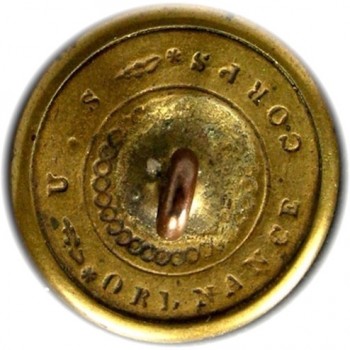
1834-51 Federal Ordnance Department Officer’s Staff Button
Color: A Gilded Brown.
Metal: Low Convex, 3-Piece Wide Rim, Raised Design, Gilded Brass.
Size: 21.70mm. Coat Size
Albert’s Number: OC 3: RV 12
Tice’s Number: ORD 200D.1
Variation: Large Bomb with a Tree like Flame / Double Ring Cross Cannons / Initials U S.
Present Condition: An Excavated Example, Strong Planchet Condition, A Strong High Relief Pattern Remains.
Isabela’s Notes: This button was intended for officers who served in the Ordnance Department. The pattern was made by a number of American manufacturers between 1834 & 1851. This button has been found at several Civil War sites, but was mostly used during the Mexican War. There appears to be 4 categories of die variants that differentiate by the bomb’s fuse. The first has a wide fuse hole, the second has a medium fuse hole, the third has a spaghetti like fuse hole, and the fourth has a narrow spout or tree like fuse The button’s pattern depicts a Large Bomb with a Tree like Flame, that is set above Double Ringed Cross Cannons. Upon the Cannon’s Barrels is the initials, “U S” in high relief. There is a flat picture frame border around the inner lined convex field.
Reverse Button Analysis: This is a three one-piece button with a copper loop shank. The shank is original, straight, and intact. * graphic design U.S. graphics design* / ORDNANCE CORPS dm inner ring of circles. (United States 10)
Picture Courtesy of Harry Ridgeway.
Robert’s Notes: The combination of both the outdate style, as well as the location of digger finds in known civil war battles makes this style button makes very likely a re-purposed Confederate used button by their Artillerymen.
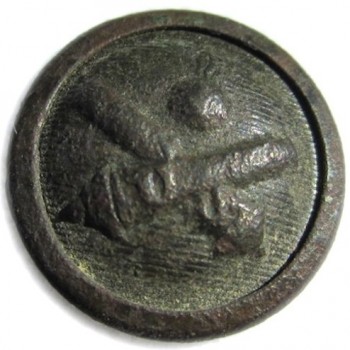
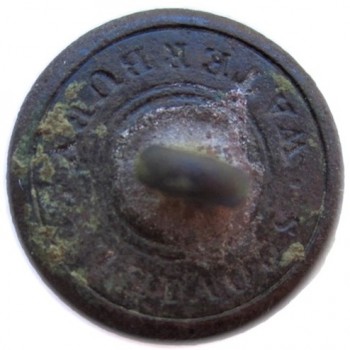
1834-51 Federal Ordnance Department
Color: A Silvery Brown.
Metal: Low Convex, 3-Piece Wide Rim, Raised Design, Gilded Brass.
Size: 15.06mm. Cuff Size
Albert’s Number: OC 3Bv.: RV 12
Tice’s Number: ORD200 Bsa.1
Variation: Small Bomb with a Small Fuse Flame / Double Ring Cross Cannons / U S Initials.
Present Condition: An Excavated Specimen, Good Planchet Condition, Good High Relief Pattern Remains.
Robert’s Notes: This button has three known die variants for the bomb’s fuse flame in the small cuff pattern. The first has a small fuse flame, the second has a feathery fuse flame, and the last has a wind blown fuse flame. The button’s pattern depicts a Small Bomb with a Small Fuse Flame that is set over a pair of Double Ringed Cross Cannons. Upon the Cannon’s Barrels is the country’s initials, “U S” in high relief. The high relief pattern is set on a lined convex field with an angled picture frame edge border. Ordnance cuff buttons are usually hard to obtain without shanks, and un dug specimens are the rarity.
Reverse Button Analysis: This is a 3-piece button with a loop shank. The shank is original, straight, and intact. .SCOVILLS./WATERBURY dm.
Excavated on a Civil War Battle field site, Berkley’s Plantation, (near Harrison’s Landing) VA. Most likely Army of the Potomac.
The RJ Silverstein Collection.

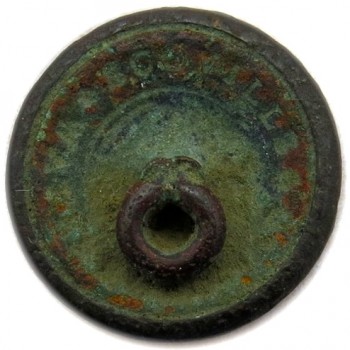 

1834-51 Federal Ordnance Department
Color: A Greenish-Brown Patina.
Metal: Low Convex, 3-Piece Wide Rim, Raised Design, Gilded Brass.
Size: 15mm. Cuff Size
Albert’s Number: Unlisted Die Variant Similar to OC 3Bv.: RV 100
Tice’s Number: Unlisted Die Variant Similar to ORD 200 Bsb
Variation: Small Bomb with a Wind Blown Fuse Flame / Double Ring Cross Cannons / U S Initials.
Present Condition: An Excavated Specimen, Good Planchet Condition, Good High Relief Pattern Remains.
Robert’s Notes: This is another die variant made by scovills. The button’s pattern depicts a Small Bomb with a Wind Blown Fuse Flame that is above a pair of Double Ringed Cross Cannons. On the Cannon’s Barrels is the country’s initials, “U S” in high relief. The high relief pattern is set on a lined convex field with an angled picture frame edge border. This die variant would be the most difficult to obtain by collectors.
Reverse Button Analysis: This is a 3-piece button with a loop shank. The shank is original, straight, and intact. .SCOVILLS./WATERBURY dm.
The RJ Silverstein Collection.
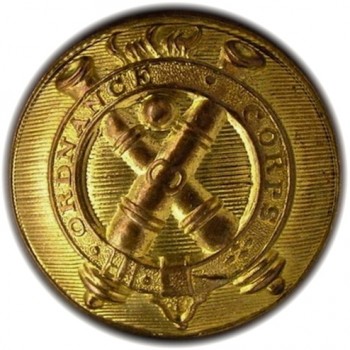
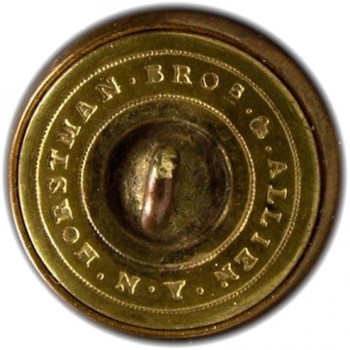
1860’s to Post War Federal Ordnance Department
Color: Antique Golden Brown.
Metal: 2-Piece, Convex, Raised Design, Gilded Brass.
Size: 23.20mm. Coat Size
Albert’s Number: OC 4: RV 5
Tice’s Number: ORD 209B.1
Variation: Four Double Ringed Cross Cannons / Large Angled Ringed Breech / 90 Degree Angles / Raised Dots / Four Small Decorative Elongated Diamond.
Present Condition: A Non Excavated Example, Exceptional Planchet Condition, Exceptional High Relief Pattern.
Isabela’s Notes: The pattern dates from the early 1840’s, but this particular button’s back mark dates to 1860. Steele & Johnson could have subcontracted these (Horstman A01) There are two known die variants made for this pattern. One with single ring cannon tubes, and the other with double ringed tubes. More then one manufacturer did make this pattern, so the buckled garter is distinctive to each manufacturer. The button’s pattern depicts Four Double Ringed Cross Cannons with a Large Angled Ringed Breech. In this die variant, the cannon’s tubes are crossed at angles Less then 90 Degrees. There is a flaming bomb set between the cannon’s top cross hatch, and has it’s flame above the buckled garter. Circling on top of the cannon’s tubes is a Buckled Garter with a foundation of Raised Dots. Written within the garter’s channel is the designation “ORDNANCE * CORPS” in raised Roman Font Capital Letters; followed by Four Small Decorative Elongated Diamonds, a buckle/strap, a Buckle Hole, a small Buckle, and an Additional Buckle Hole. The high relief pattern is set on a convex lined field, with a thin raised collar’s edge. Collectors usually take distinctive note between manufacturer’s specimen’s who’s cannon barrels are crossed at angles less then 90 degrees, and the ones that are crossed at right angles. Both types were manufactured from the early 1840’s. Also there is a decorative distinction to the buckled garters themselves.
Reverse Button Analysis: This is a two-piece-piece button with a copper loop shank. The shank is original, straight, and intact. dm HORSTMAN . BROs . & . ALLIEN./N.Y. within a dotted channel ring. shank is shallow concave well.
Picture Courtesy of Harry Ridgeway.
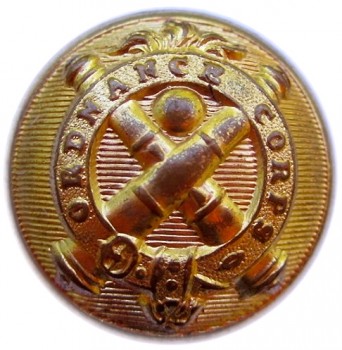
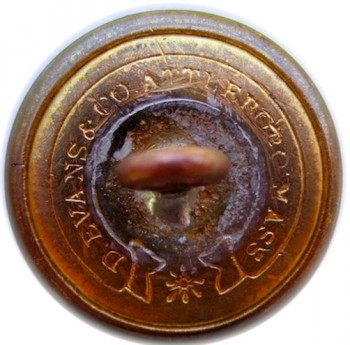
1840’s to Post War Federal Ordnance Department
Color: Antique Golden Brown.
Metal: 2-Piece, Convex, Raised Design, Gilded Brass.
Size: 22.93mm. Coat Size
Albert’s Number: OC 5.: RV 2
Tice’s Number: ORD 215A.1
Variation: Four Single Rings Cross Cannons / Right Angles / Buckled Garter – Pebbled / One Decorative Elongated Diamond / Buckle.
Present Condition: A Non Excavated Specimen, Strong Planchet Casting, A Strong High Relief Pattern Remains.
Robert’s Notes: The pattern dates from the early 1840’s, but this particular button’s back mark dates to the early 1850’s. It was originally intended for officers of the Ordnance Dept. who were responsible for the procurement and development of weapons for the Army to use. This pattern was made by several manufacturers, so several die variants are known. The button’s pattern depicts Four Single Rings on a set of Cross Cannons. In this die variant, the cannon’s tubes are set at Right Angles. There is a flaming bomb set between the cannon’s top cross hatch, and it’s flame is above the buckled garter. Circling over the cannon’s tubes is a raised Buckled Garter that is Pebbled. Written within the garter’s channel is the designation, “ORDNANCE CORPS” in Thick Roman Font Capital Letters. This is followed by One Decorative Elongated Diamond, a circling buckle strap followed by a Round Buckle. The high relief pattern is set on a convex lined field with a thin raised edge. Collectors usually take distinctive note between manufacturer’s specimen’s who’s cannon barrels are crossed at angles less then 90 degrees, and the ones that are crossed at right angles. Both types were manufactured from the early 1840’s. Also there is a decorative distinction to the buckled garters themselves.
Reverse Button Analysis: This is a two-piece-piece button with a copper loop shank. The shank is original, straight, and intact. dm D.EVANS & CO.ATTLEBORO. MASS within swallow tailed ribbon with rosette between the ends.
The
RJ Silverstein Collection.

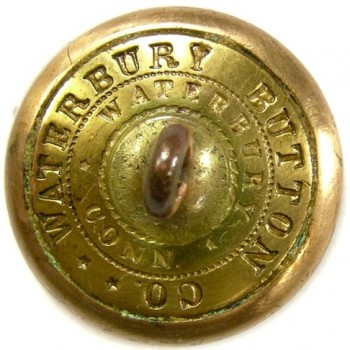 

1860’s to Post War Federal Ordnance Department
Color: A Bright Gold.
Metal: 2 Piece, Convex, Raised Design, Gilded Brass.
Size: 23.03mm. Coat Size
Albert’s Number: OC 5.: RV 2
Tice’s Number: ORD 215A.6
Variation: Four Single Ringed Cross Cannons / Right Angles / Buckled Garter – Raised Dots 4 Additional Buckle Holes / One Decorative Elongated Diamond.
Present Condition: A Non Excavated Example, Exceptional Planchet Condition, Exceptional High Relief Pattern Remains.
Robert’s Notes: This is another manufacturer’s pattern who’s die variant is just slightly different. In this variant, the buckle holes are open circles, and the Roman Font capital letters are thinner. The button’s pattern depicts Four Single Rings on a set of Cross Cannons. In this die variant, the cannon’s tubes are set at Right Angles. There is a flaming bomb set between the cannon’s top cross hatch, and it’s flame is above the buckled garter. Circling on top of the cannon’s tubes is a Buckled Garter with a Raised Dot foundation. Written within the garter’s channel is the designation, “ORDNANCE CORPS” in Thin Roman Font Capital Letters. This is followed by One Decorative Elongated Diamond, a circling buckle strap followed by a Buckle Hole, a Round Buckle, and Two more Buckle Holes. The high relief pattern is set on a convex lined field with a thin raised edge. Collectors usually take distinctive note between manufacturer’s specimen’s who’s cannon barrels are crossed at angles less then 90 degrees, and the ones that are crossed at right angles. Both types were manufactured from the early 1840’s. Also there is a decorative distinction to the buckled garters themselves.
Reverse Button Analysis: This is a two-piece-piece button with a copper loop shank. The shank is original, straight, and intact. *WATERBURY BUTTON CO. **/ WATERBURY * CONN.* is within 2 dm ring of dots, and large periphery ring.
The RJ Silverstein Collection.

